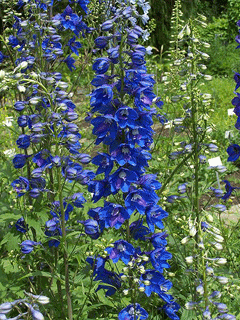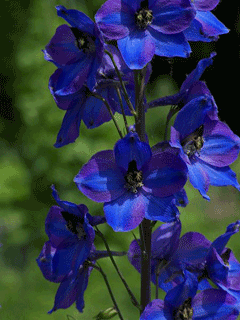 |
|
http://commons.wikimedia.org/wiki/User:Val%C3%A9rie75 |
 |
| http://commons.wikimedia.org/wiki/User:Val%C3%A9rie75 |
Translate this page:
Summary
Bloom Color: Blue, Pink, Purple, White. Main Bloom Time: Early summer, Late spring, Mid summer. Form: Upright or erect.
Physical Characteristics

 Delphinium elatum is a PERENNIAL growing to 1 m (3ft 3in) by 0.3 m (1ft) at a medium rate.
Delphinium elatum is a PERENNIAL growing to 1 m (3ft 3in) by 0.3 m (1ft) at a medium rate.
See above for USDA hardiness. It is hardy to UK zone 3. It is in flower from June to July, and the seeds ripen from July to August. The species is hermaphrodite (has both male and female organs).
Suitable for: light (sandy), medium (loamy) and heavy (clay) soils and prefers well-drained soil. Suitable pH: mildly acid, neutral and basic (mildly alkaline) soils. It cannot grow in the shade. It prefers moist soil.
UK Hardiness Map
US Hardiness Map
Synonyms
Plant Habitats
Cultivated Beds;
Edible Uses
References More on Edible Uses
Medicinal Uses
Plants For A Future can not take any responsibility for any adverse effects from the use of plants. Always seek advice from a professional before using a plant medicinally.
Anthelmintic Aperient Diuretic Emetic
The whole plant, but especially the seeds, is anthelmintic, aperient, diuretic and emetic[240].
References More on Medicinal Uses
The Bookshop: Edible Plant Books
Our Latest books on Perennial Plants For Food Forests and Permaculture Gardens in paperback or digital formats.

Edible Tropical Plants
Food Forest Plants for Hotter Conditions: 250+ Plants For Tropical Food Forests & Permaculture Gardens.
More

Edible Temperate Plants
Plants for Your Food Forest: 500 Plants for Temperate Food Forests & Permaculture Gardens.
More

More Books
PFAF have eight books available in paperback and digital formats. Browse the shop for more information.
Shop Now
Other Uses
The seed contains 1.7% alkaloids and is used as an insecticide[240].
Special Uses
References More on Other Uses
Cultivation details
Landscape Uses:Border, Foundation, Massing, Seashore, Specimen. Prefers a rich well-drained soil that stays moist in the summer[111, 187]. Dislikes water-logged soils[200], it is liable to die out in heavy soils over winter[111]. Requires an open sunny position[188]. This species is the main parent of the many tall hybrid forms of delphiniums that are commonly grown as garden ornamentals[200]. A variable species in the wild, varying in height from 40cm to 2 metres[200]. A greedy plant, inhibiting the growth of nearby plants, especially legumes[54]. Special Features:
Attracts birds, All or parts of this plant are poisonous, Suitable for cut flowers, Suitable for dried flowers.
References Carbon Farming Information and Carbon Sequestration Information
Temperature Converter
Type a value in the Celsius field to convert the value to Fahrenheit:
Fahrenheit:
The PFAF Bookshop
Plants For A Future have a number of books available in paperback and digital form. Book titles include Edible Plants, Edible Perennials, Edible Trees,Edible Shrubs, Woodland Gardening, and Temperate Food Forest Plants. Our new book is Food Forest Plants For Hotter Conditions (Tropical and Sub-Tropical).
Shop Now
Plant Propagation
Seed - sow March/April in a cold frame or May outdoors[111]. Keep moist and in a shady position until germination takes place[175]. The seed has a limited viability so it should be stored in a sealed container at about 3°c[200]. Temperatures above 15°c inhibit germination[175]. The seed usually germinates in 2 - 9 weeks at 15°c[175]. When they are large enough to handle, prick the seedlings out into individual pots and plant them out into their permanent positions in the summer. Cuttings of basal shoots in April/May, taken before they become hollow at the base, and planted in a cold frame[111]. Division in spring[111] or early autumn[200].
Other Names
If available other names are mentioned here
Native Range
TEMPERATE ASIA: Russian Federation-Western Siberia (Western Siberia (south)), Russian Federation-Eastern Siberia (Eastern Siberia (south)), Kazakhstan (southeast), Kyrgyzstan, Mongolia (north), China (Xinjiang Uygur Zizhiqu) EUROPE: Austria, Switzerland, Czech Republic, Poland (south), Slovakia, Russian Federation (European part), Estonia, Lithuania, Latvia, Italy (northwest), Romania, Serbia, France (southeast)
Weed Potential
Right plant wrong place. We are currently updating this section.
Please note that a plant may be invasive in one area but may not in your area so it's worth checking.
Conservation Status
IUCN Red List of Threatened Plants Status :

Growth: S = slow M = medium F = fast. Soil: L = light (sandy) M = medium H = heavy (clay). pH: A = acid N = neutral B = basic (alkaline). Shade: F = full shade S = semi-shade N = no shade. Moisture: D = dry M = Moist We = wet Wa = water.
Now available:
Food Forest Plants for Mediterranean Conditions
350+ Perennial Plants For Mediterranean and Drier Food Forests and Permaculture Gardens.
[Paperback and eBook]
This is the third in Plants For A Future's series of plant guides for food forests tailored to
specific climate zones. Following volumes on temperate and tropical ecosystems, this book focuses
on species suited to Mediterranean conditions—regions with hot, dry summers and cool, wet winters,
often facing the added challenge of climate change.
Read More
Expert comment
Author
L.
Botanical References
200266
Links / References
For a list of references used on this page please go here
Readers comment